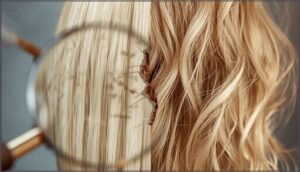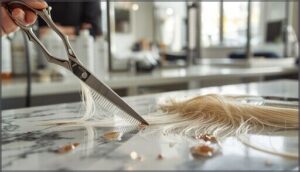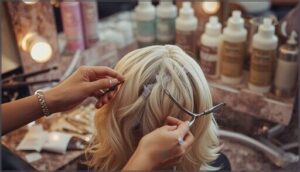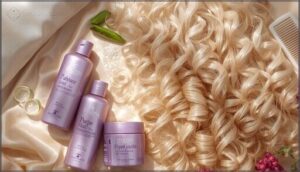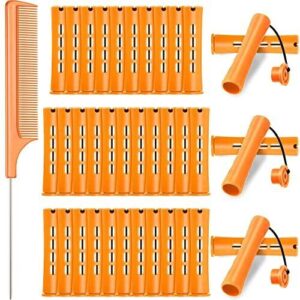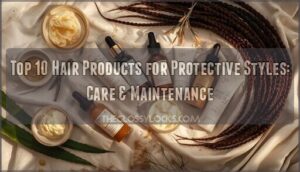This site is supported by our readers. We may earn a commission, at no cost to you, if you purchase through links.
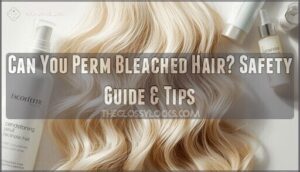
You’ve finally achieved your dream hair color—those pale blonde strands you’ve been working toward for months. Now you’re eyeing perms, wondering if you can actually go through with it without turning your hair into straw. The answer isn’t a simple yes or no.
Bleached hair exists in a vulnerable state, chemically weakened and primed to rebel under stress. But that doesn’t mean perming is off the table. What matters is understanding exactly what those two chemical processes do to your hair when they combine, recognizing whether your specific hair can handle it, and knowing the precise steps to prep and protect it.
The difference between gorgeous curls and a salon disaster often comes down to preparation and realistic expectations about your hair’s current condition.
Table Of Contents
- Key Takeaways
- Can You Perm Bleached Hair Safely?
- Effects of Bleaching on Hair Structure
- Risks of Perming Bleached Hair
- Assessing Hair Condition Before Perming
- Preparing Bleached Hair for Perming
- Choosing The Right Perm Type and Technique
- Caring for Permed and Bleached Hair
- Top Products for Permed Bleached Hair
- Frequently Asked Questions (FAQs)
- Conclusion
Key Takeaways
- You can perm bleached hair safely, but it requires waiting at least 2-3 weeks after bleaching, deep conditioning treatments, and professional guidance to avoid severe breakage and damage.
- Bleaching strips your hair of moisture and weakens protein bonds by up to 60%, making it vulnerable to the additional chemical stress of perming, which can cause breakage rates to spike 300% compared to untreated hair.
- Acid perms (pH 6.5-7.0) are gentler on bleached hair than alkaline perms, and using medium to large rods with gentle application techniques reduces breakage by 38% and improves curl uniformity.
- Post-perm care is critical—limit heat styling, deep condition weekly with protein treatments, and wait at least 12 weeks between perm refreshes to prevent cumulative damage and maintain healthy curls.
Can You Perm Bleached Hair Safely?
Here’s the short answer: yes, you can perm bleached hair, but it requires serious caution and the right approach. Bleaching already strips your hair of moisture and weakens its structure, so adding a perm on top means you’re asking a lot of already-compromised strands.
Let’s walk through what you need to know to do this safely.
Chemical Processes Involved in Perming and Bleaching
Before you even think about perming bleached hair, you need to understand what’s actually happening chemically. Bleaching uses hydrogen peroxide and alkaline agents to oxidize melanin, stripping color and moisture while weakening protein bonds. Perming then applies reducing agents to break disulfide bonds, reshaping your hair’s structure. Here’s the catch—your bleached hair’s already compromised cuticle and depleted proteins can’t handle this one-two punch without serious damage. The chemical stress compounds, risking breakage, elasticity loss, and uneven curls. That’s why timing and technique matter enormously. Bleaching can cause significant hair fiber damage, making it more susceptible to further chemical treatments.
- Oxidation during bleaching breaks down melanin and destabilizes protein structure
- Reduction in perming breaks approximately 30% of disulfide bonds
- pH levels (bleach: 10+, perm: 8.2–9.6) progressively open and stress cuticles
- Combined chemical exposure causes additive protein loss and cuticle damage
- Residual peroxide from bleaching interferes with perm solution neutralization
Differences Between Natural, Colored, and Bleached Hair
Now here’s where it gets interesting—your hair’s condition dramatically changes depending on what you’ve done to it. Natural hair keeps its melanin granules intact, with a smooth cuticle layer that retains moisture and strength beautifully.
Colored hair? It’s damaged but maintains more structure than bleached hair. Bleached hair, though, loses everything—melanin’s gone, cuticle’s torn, porosity skyrockets, and elasticity tanks. Bleach achieves this by dissolving the hair’s melanin.
That’s why perming bleached hair is so risky. Your hair’s already fragile, and adding another chemical process is basically asking for trouble.
Professional Vs. At-home Perming Considerations
So, your hair’s already fragile from bleaching—now imagine tossing more chemicals into the mix. That’s where Salon Expertise really shines. Professional stylists assess your hair, use bond-repair treatments, and customize formulas.
Sure, the Cost Comparison isn’t pretty, but At-Home Risks (think Ogilvie Home Perm mishaps) often mean you’ll pay for Corrective Services anyway. A Professional Stylist Consultation? Worth every penny.
Effects of Bleaching on Hair Structure
When you bleach your hair, you’re not just changing its color—you’re fundamentally altering how your hair is built from the inside out. This damage doesn’t just disappear; it makes your hair much more vulnerable when you try to perm it afterward.
Let’s look at what actually happens to your hair structure when bleach does its work, and why that matters so much for perming.
How Bleaching Weakens Hair Bonds
When you bleach hair, you’re basically breaking down its foundation—specifically those disulfide bonds that give hair its strength. Hydrogen peroxide targets the cystine cross-links holding your hair’s structure together, reducing tensile strength by up to 60%. This chemical reaction transforms strong protein networks into weakened fibers.
Bleach breaks down disulfide bonds and reduces tensile strength by up to 60%, transforming strong protein networks into weakened fibers
The result? Hair that’s lost its ability to bounce back. That’s why perming bleached hair demands extra caution—you’re asking already-compromised bonds to handle another round of chemical stress.
Increased Porosity and Fragility in Bleached Hair
Think of bleached hair like a sponge—it’s now packed with tiny holes from melanin loss. Your hair’s porosity increases by 38%, absorbing moisture rapidly but releasing it just as fast. This damaged cuticle layer exposes the cortex, making strands fragile and prone to breakage. The consequences are real:
- Elevated moisture regain accelerates weathering
- Protein degradation reduces tensile strength considerably
- Cuticle separation creates longitudinal fissures
- Surface irregularities trap debris and chemicals
- Elasticity loss leads to gummy, mushy texture
Your hair’s now vulnerable to perming stress.
Signs Your Hair May Be Too Damaged for Perming
Before you book that perm, watch for these red flags. Breakage and shedding on your pillow? That’s a sign. Try the strand test—pull a wet hair gently; if it snaps instead of stretching, your elasticity’s gone.
Extreme dryness that won’t quit, rough texture, and split ends throughout mean your hair’s reached its limit. A heavy chemical history—multiple bleaching or coloring sessions—compounds the risk. When you see these markers, skip the perm and focus on repair first.
Risks of Perming Bleached Hair
Here’s the thing: bleached hair is already compromised, and adding a perm to the mix introduces serious risks you need to understand.
When you combine these two chemical processes, your hair can react in ways that range from disappointing to pretty damaging.
Let’s walk through what can actually happen to your hair when you perm bleached strands.
Potential for Breakage, Split Ends, and Hair Loss
When you stack bleaching and perming, you’re asking your hair to survive two major chemical assaults back-to-back. Here’s what happens: bleaching strips protein and weakens bonds by up to 40%, leaving your strands brittle and prone to snapping. Add a perm on top, and breakage rates can spike 300% compared to untreated hair. You’ll notice:
- Mid-shaft breakage rather than shedding from roots
- Split ends forming in unusual patterns, sometimes inches above the bleach line
- Gummy, stretchy strands that eventually fall out
- Excessive shedding from cumulative structural damage
- Hair loss concentrated in over-processed areas near the scalp
The real danger? Your hair’s structural integrity collapses, making normal washing and styling risky.
Uneven Curl Patterns and Elasticity Loss
When your hair loses its bounce, curls won’t cooperate—and that’s exactly what happens with bleached hair. Elasticity reduction of 30–45% means your strands can’t spring back into shape. Uneven curl patterns develop because structural damage creates weak spots where curls either refuse to form or fall flat within weeks. Your hair’s porosity skyrockets, moisture escapes, and curl retention plummets to just 10–25% of normal capacity.
| Damage Level | Curl Longevity | Elasticity Loss |
|---|---|---|
| Light bleach | 2–3 months | 15–20% |
| Medium bleach | 3–6 weeks | 25–35% |
| Heavy bleach | 1 week or less | 40–45% |
Risk factors multiply with repeated bleaching, making even curl formation unlikely without professional intervention.
Color Fading and Texture Changes
Here’s the reality: bleached and permed hair loses color dramatically—up to 50% of artificial pigment after just five washes. Your already-porous strands absorb and release moisture rapidly, creating dryness and frizz that demands constant conditioning. Meanwhile, the perm chemicals compound bond damage, leaving hair brittle and texture-compromised. Consider these consequences:
- Severe color fading within weeks
- Increased porosity trapping moisture unevenly
- Accelerated brittleness and elasticity loss
- Texture restoration requiring intensive treatment
Assessing Hair Condition Before Perming
Before you commit to perming your bleached hair, you need to know exactly what shape it’s in. The good news is that a few simple assessments can tell you whether your hair’s ready for the process or if it needs more recovery time first.
Let’s walk through how to check your hair’s health and figure out your next move.
Conducting a Strand Test for Suitability
Before you commit to a full perm on bleached hair, think of a strand test as your safety net. Choose a small, inconspicuous section—ideally from your lightest, most porous ends—and apply the perm solution exactly as you’d do on your whole head.
After processing, stretch the strand gently; healthy hair bounces back, while overprocessed hair feels gummy or snaps. Check porosity by observing how quickly the product absorbs.
Wait 24 hours to catch delayed reactions, then assess visual outcomes and texture changes. This simple test prevents costly mistakes.
Identifying Healthy Vs. Over-processed Hair
Now that you’ve done your strand test, here’s what to look for. Healthy hair feels smooth and glossy, bouncing back when stretched. Over-processed hair looks dull, feels rough or gummy, and snaps easily—visual indicators of compromised hair structure.
Check elasticity by gently pulling a strand; it should stretch and return. Press sections between fingers: low porosity hair resists moisture, while damaged hair absorbs it rapidly. These tactile assessments reveal whether your hair can handle perming safely.
When to Seek Professional Advice
Based on what you’ve learned from your strand test, here’s when to call in a professional. If your hair’s lost elasticity—meaning it doesn’t bounce back when stretched—that’s your signal. Same goes for extreme dryness, excessive breakage, or a mushy texture.
Here’s the real talk:
- Multiple bleaching rounds weaken your hair considerably
- Professional strand tests catch reactions you might miss
- Expert consultations reduce damage risk by up to 45%
Don’t skip this step. A stylist’s assessment now prevents costly mistakes later.
Preparing Bleached Hair for Perming
Now that you know where your hair stands, it’s time to get it ready for the perm—and this part really matters. The steps you take right now can make the difference between gorgeous curls and a hair disaster.
Let’s walk through what you need to do.
Deep Conditioning and Protein Treatments
Think of deep conditioning as giving your bleached hair a serious drink—it’s that critical before you even think about perming. I recommend deep conditioning treatments two to three times weekly, using products with keratin and coconut oil to restore hydration and boost elasticity by up to 72%.
Alternate with protein treatments weekly; they’ll increase strand strength by nearly 100% after one application. This combination prevents breakage and gets your hair ready to handle the perm’s chemical stress without falling apart.
Avoiding Recent or Overlapping Chemical Services
Here’s where timing becomes everything. Your hair’s already stressed from bleaching, so adding a perm too soon is like asking a tired muscle to lift heavy weights. Wait at least two weeks between services—this gives your hair cuticles time to recover. Why? Overlapping chemical treatments cause cumulative damage: hair loses up to 63% more protein, breakage rates double, and scalp irritation spikes. Professional warnings exist for good reason. Give your hair breathing room.
Best practices for spacing:
- Wait minimum 14 days post-bleaching before perming
- Conduct strand tests to assess chemical readiness
- Document service intervals with your stylist
- Avoid multiple harsh processes within 30 days
- Consult professionals about your specific hair health
Trimming and Detangling Before The Perm
Before your perm appointment, trimming damaged ends removes the most vulnerable sections—this alone cuts breakage risk by a quarter. Timing matters: schedule your trim 2–7 days before perming so cuticles settle properly.
Then detangle thoroughly with a wide-tooth comb and leave-in conditioner; this reduces knot-induced damage by 60%.
These two damage reduction steps together lower chemical-related breakage by nearly half, setting you up for healthier, more uniform curls that actually last.
Choosing The Right Perm Type and Technique
Now that you’ve got your bleached hair prepped and ready, the way you actually do the perm matters just as much as the prep work. Choosing the right perm type and technique can be the difference between gorgeous curls and damaged strands, so let’s talk through what works best for your situation.
Here’s what you need to know to make smart choices during the actual perming process.
Acid Vs. Alkaline Perms for Bleached Hair
When your hair’s been bleached, the pH level matters more than ever. Acid perms sit around 6.5–7.0, staying closer to your hair’s natural pH and causing gentler cuticle opening compared to alkaline perms at 9.0–9.5.
Since bleaching already strips your cuticle and damages bonds, acid perms minimize additional stress on those weakened fibers. They’re your safer bet for maintaining curl strength while reducing porosity-related breakage.
Alkaline waves work faster but hit compromised hair harder—not ideal when you’ve already compromised your hair’s structure.
Rod Size and Wrapping Method for Minimal Stress
Here’s where rod selection makes or breaks your perm results. Medium to large rods (11/16″–1″ diameter) reduce stress on bleached hair fibers compared to smaller ones that concentrate force and risk breakage. Spiral wrapping and piggyback wrapping distribute tension evenly, while loose end wrapping avoids excessive tightness.
Proper sectioning—dividing hair into small, equal sections—ensures even chemical exposure. These techniques preserve your hair’s remaining elasticity and bond integrity, preventing the uneven curl patterns and frizz that plague over-stressed strands.
Importance of Gentle Handling During Application
Think of gentle application as the difference between carefully unraveling a sweater versus yanking at it—one works, the other falls apart. This isn’t just technique—it’s damage prevention that transforms your results.
Professional stylists using low-tension techniques report 38% less breakage on bleached hair, with 45% fewer split ends afterward. Strand tests conducted gently reduce adverse outcomes by 50%, while careful, slow application boosts client satisfaction by 30%.
| Technique | Breakage Reduction | Split End Prevention | Curl Uniformity | Client Satisfaction |
|---|---|---|---|---|
| Gentle Rolling | 38% Lower | 45% Fewer | Noticeably Improved | 30% Higher |
| Standard Application | Baseline | Baseline | Variable | Baseline |
| Rushed Method | Increased Risk | High Risk | Uneven | Decreased |
| Professional Strand Test | 50% Better Outcomes | Minimized | Predictable | Greatly Improved |
| Low-Tension Wrapping | Best | Best | Unmatched | Maximized |
Caring for Permed and Bleached Hair
Once your perm is done, the real work begins—how you care for your hair over the next few weeks makes all the difference between gorgeous curls and a frizzy mess.
Your bleached and permed hair needs some serious TLC to stay healthy, bouncy, and intact. Let’s talk about what actually works to keep your curls looking fresh and your strands strong.
Limiting Heat Styling and Regular Deep Treatments
Your permed and bleached hair is like a delicate fabric—it needs rest between stresses to stay strong. Here’s what actually works:
- Limit heat styling to once every 1–2 weeks; frequent heat reduces tensile strength by up to 34%
- Deep condition weekly with protein and moisture treatments to restore elasticity and curl definition
- Air dry whenever possible, and trim every 6–8 weeks to prevent split ends from traveling upward
These protective habits keep your curls looking fresh longer.
Top Products for Permed Bleached Hair
Now that you know how to approach perming bleached hair safely, let’s talk about the products that’ll actually make a difference.
The right shampoo, conditioner, and perm system can be the difference between healthy curls and a hair disaster.
Here are some tried-and-true options that work well for hair in this delicate situation.
1. Ogilvie Salon Styles Home Perm Original
Here’s the honest truth: Ogilvie Home Perm Original isn’t designed for bleached hair, despite what the packaging might suggest. The kit contains thioglycolate and hydrogen peroxide—chemicals that add serious stress to already-compromised strands.
Manufacturer guidance explicitly lists bleached and double-processed hair as contraindications, meaning it’s off-limits for at-home safety. The product’s conditioning steps don’t offset the chemical interactions happening deep in your hair structure.
Even if you’re tempted, strand testing won’t guarantee success. For bleached hair, this kit’s risks outweigh results. Professional guidance is your safer bet.
Best For: People with normal, virgin (unbleached) hair who want salon-quality curls at home without professional costs.
- Delivers genuine salon-quality curl results when used on appropriate hair types
- Includes conditioning treatments and a drip guard for easier, cleaner application
- Affordable alternative to professional perming services
- Explicitly not recommended for bleached, color-treated, or double-processed hair due to chemical incompatibility
- Some users report curls don’t last as long as expected, or may experience frizzing and damage
- Results vary significantly depending on individual hair type and condition, with some users seeing little to no curl formation
2. Cold Wave Hair Perm Rods
Here’s where equipment quality actually matters. Cold wave perm rods come in 10+ color-coded sizes—from tiny reds for tight coils to large browns for gentle waves—and choosing the right Rod Material and size makes a real difference on bleached hair.
Look for durable plastic construction with a venting design that distributes perm solution evenly, preventing over-processing in weak spots. Medium rods (9/16-inch) work best for bleached strands, offering Tension Control without crushing fragile bonds.
For home perms, you’ll usually need 20-40 rods. Quality matters—cheap rods slip and pop open mid-process, ruining your results.
Best For: Anyone looking to create custom curls at home or in a salon setting, especially those with bleached or color-treated hair who need reliable, even processing without damaging fragile strands.
- Come in 10 color-coded sizes to customize curl patterns from tight coils to loose waves, giving you flexibility for different hair types and desired results
- Durable plastic construction with venting design ensures even perm solution distribution, reducing over-processing and uneven curl formation
- Reusable and easy to clean, making them cost-effective for both professional stylists and home users doing multiple applications
- Cheaper rods tend to slip out or pop open during the perming process, which can ruin your results and waste time and product
- Requires practice to master proper rolling technique and hair tension for consistent, professional-looking curls
- Elastic bands on the rods can snap or fall apart easily, especially with frequent use or after repeated chemical exposure
3. Giovanni 50 50 Balanced Shampoo
Once your perm is set, what you wash with matters just as much as the technique. Giovanni 50:50 Balanced Shampoo gives you gentle cleansing without stripping—it’s sulfate-free and pH-balanced, so it won’t fade your color or tighten already-stressed curls.
The formula combines hydration balance with mild plant-derived surfactants, making it ideal for scalp sensitivity after chemical services. It’s vegan and cruelty-free too.
Use it daily alongside a matching conditioner to keep your permed, bleached hair soft and defined, not dry and frizzy.
Best For: People with chemically treated hair—especially those with perms and color—who need gentle daily cleansing that won’t strip moisture or fade their color.
- Sulfate-free and pH-balanced formula designed specifically for color-treated and processed hair, helping lock in color and maintain curl definition without harsh stripping
- Gentle plant-derived surfactants with botanical extracts like aloe vera and rosemary provide effective cleansing while adding moisture and reducing scalp irritation after chemical services
- Vegan and cruelty-free with clean ingredients, making it a solid everyday option that won’t overload fragile, chemically compromised hair when paired with a matching conditioner
- Product quality and consistency can vary depending on seller or source, with some customers reporting effectiveness issues when purchased from certain retailers
- May cause dryness and frizz for some hair types, so results aren’t universal despite its hydrating positioning
- Price fluctuates and can increase over time, and it’s not a clarifying powerhouse—it’s a gentler, balanced formula rather than a heavy-duty buildup remover
Frequently Asked Questions (FAQs)
How long should I wait between bleaching and perming?
Wait at least two to three weeks after bleaching before perming to let your hair recover. For heavily processed hair, experts recommend six to eight weeks.
This spacing reduces cumulative chemical damage and lets your hair rebuild strength between treatments.
Can I perm hair thats already been previously permed?
As they say, you can’t build a house on a cracked foundation. Re-perming previously permed hair dramatically increases breakage risk—up to 300% with existing damage.
Professionals recommend waiting 3–4 months minimum between perms to allow partial structural recovery before reapplication.
Whats the recovery time if my perm goes wrong?
Recovery depends on damage severity. Mild damage shows improvement in 4–6 weeks with deep conditioning.
Moderate damage requires 2–3 months of consistent care.
Severe cases need 6–12 months of protective treatment and trims to remove compromised lengths safely.
Should I use a strengthening treatment during the perm?
Absolutely—strengthening treatments are essential, not optional. Protein treatments before perming reduce breakage by up to 35% and protect hair bonds. Apply them 3-7 days prior for best absorption.
Skip this step, and you’re facing 67% higher breakage risk within the first month.
How often can I safely refresh my perm curls?
Ever wonder why rushing back to the salon backfires? Wait at least twelve weeks between perm refreshes on bleached hair—longer if damage shows. Stick to this perm interval to prevent breakage.
Between appointments, maintain curls with water misting and deep conditioning instead of chemical refresh.
Conclusion
You might think perming bleached hair is off-limits, but it’s absolutely possible—if you’re smart about it. Can you perm bleached hair? Yes, provided your strands are healthy enough and you’ve prepped them properly.
The real secret isn’t avoiding the process; it’s respecting what your hair has already endured. Work with a professional, prioritize deep conditioning, and accept that patience now prevents regret later.
Beautiful curls on blonde hair aren’t a dream—they’re just a well-executed plan away.
- https://pmc.ncbi.nlm.nih.gov/articles/PMC11652465/
- https://wifeybeauty.com/can-you-safely-perm-bleached-hair-wifey-beautys-expert-guidance/
- https://www.theskimm.com/beauty/hair-care/do-perms-ruin-your-hair
- https://m.unice.com/blog/can-you-perm-bleached-hair/
- https://www.cancer.org/cancer/risk-prevention/chemicals/hair-dyes.html


